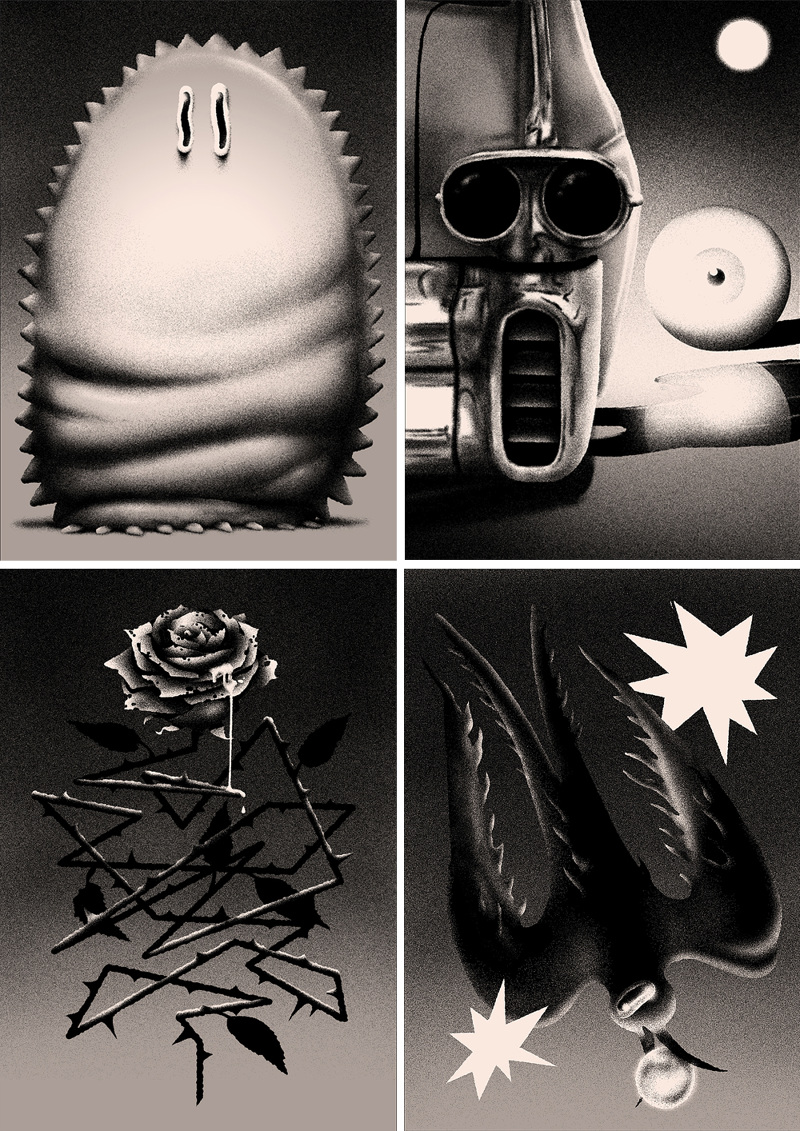interview: max loeffler
︎Interview, Illustration, Surreal
︎ Ventral Is Golden
︎Interview, Illustration, Surreal
︎ Ventral Is Golden
︎ Ventral Is Golden
Wrapped in a moody surrealistic parallel universe, Max Loeffler's illustrations can be seen as a sullen and bitter smirk towards the obscurity, monotony and ferocity of everyday life. His work does not give plausible answers,
but tries to ask significant questions such as; are you hurt, what's eating you, and do you want to live forever?
We asked him how and why he creates his imagery, and what we can expect of the future.
but tries to ask significant questions such as; are you hurt, what's eating you, and do you want to live forever?
We asked him how and why he creates his imagery, and what we can expect of the future.

Can you tell us a little about where you’re from, and how this has shaped your view of the world?
I was raised as the only son of an artist father and a loving mother in the middle of rural Germany, in a nice, little, featureless village surrounded by a huge forest and soft green hills. Growing up there may sound romantic, but tending to be a loner every now and then, it was easy for me to get caught up in my habits. Especially as a rural kid, it’s necessary to kick yourself out of your known surroundings. I waited a little too long to do this, so I guess this annoying, rural teen nerd living in a world of his own is still hanging around these days. That’s why taking off the blinders is still a big issue for me.
Does your artwork act as a repository of your childhood recollections of rural Germany, or is your imagery pulled more from your idea of the future?
I can’t deny my childhood having effect on my work today, but there are no specific events or images which I relate it to. My approach is a rather visceral and immediate one, and I realise only afterwards (if at all) what the meaning of a piece could be. I’m extremely attracted by futuristic visions and sci-fi in general. On occasion I like to include a retro romance feel into my work, which is more like the idea of the future of the past.
My expectations of the future in real-life are quite pessimistic, and as I‘m struggling with the present anyway, I think at least the future in my illustrations could be a lighthearted one.
![]()
I was raised as the only son of an artist father and a loving mother in the middle of rural Germany, in a nice, little, featureless village surrounded by a huge forest and soft green hills. Growing up there may sound romantic, but tending to be a loner every now and then, it was easy for me to get caught up in my habits. Especially as a rural kid, it’s necessary to kick yourself out of your known surroundings. I waited a little too long to do this, so I guess this annoying, rural teen nerd living in a world of his own is still hanging around these days. That’s why taking off the blinders is still a big issue for me.
Does your artwork act as a repository of your childhood recollections of rural Germany, or is your imagery pulled more from your idea of the future?
I can’t deny my childhood having effect on my work today, but there are no specific events or images which I relate it to. My approach is a rather visceral and immediate one, and I realise only afterwards (if at all) what the meaning of a piece could be. I’m extremely attracted by futuristic visions and sci-fi in general. On occasion I like to include a retro romance feel into my work, which is more like the idea of the future of the past.
My expectations of the future in real-life are quite pessimistic, and as I‘m struggling with the present anyway, I think at least the future in my illustrations could be a lighthearted one.
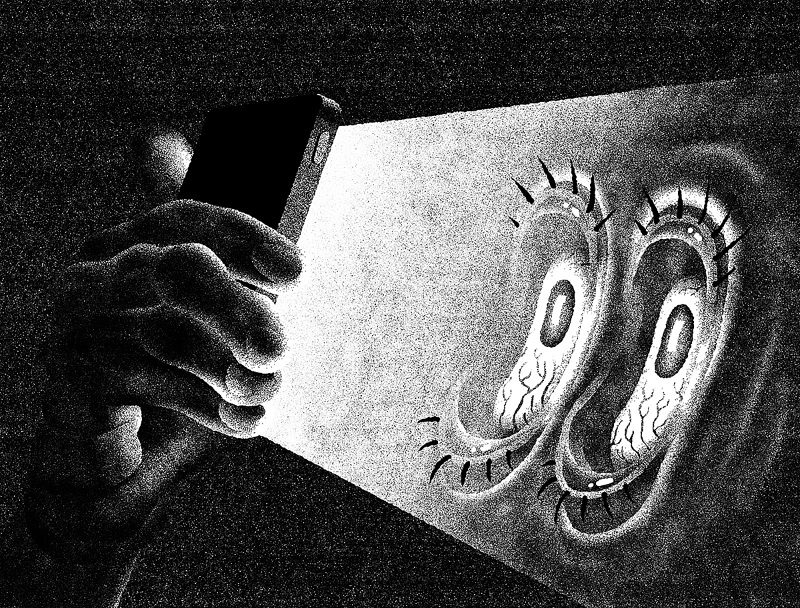
Do you have a ‘formal education’ in Art & Design? Do you think this is important?
That’s a difficult issue. Yes, I do have a formal education, but I think what brought me to where I am now is a lifelong passion for examining and diving into art as well, not least because of my Dad. My formal education began with art class in the last two years before my A Levels. Photorealistic coloured pencil drawing to be exact. After that I did an apprenticeship as a media designer, as I was unsure about a career in art.
My time at University helped to get rid of the aforementioned blinders, but it also confronted me with my own stubbornness, which regularly led to ongoing disputes with my professors, although, ultimately I do think it’s important to not regard professors as the guys who have the hang of it all. Which is what I naively believed at the beginning. I also recognised (maybe too too late on) that their valuation is not the one and only truth out there, and if they do not like your stuff it doesn’t mean that you produced something shit by default. I definitely learned just as much (if not more) from my piers. So yep, formal education is important, as long as you choose the people you want to learn from wisely.
![]()
That’s a difficult issue. Yes, I do have a formal education, but I think what brought me to where I am now is a lifelong passion for examining and diving into art as well, not least because of my Dad. My formal education began with art class in the last two years before my A Levels. Photorealistic coloured pencil drawing to be exact. After that I did an apprenticeship as a media designer, as I was unsure about a career in art.
“My approach is a rather visceral and immediate one, and I realise only afterwards what the meaning of a piece could be.”
My time at University helped to get rid of the aforementioned blinders, but it also confronted me with my own stubbornness, which regularly led to ongoing disputes with my professors, although, ultimately I do think it’s important to not regard professors as the guys who have the hang of it all. Which is what I naively believed at the beginning. I also recognised (maybe too too late on) that their valuation is not the one and only truth out there, and if they do not like your stuff it doesn’t mean that you produced something shit by default. I definitely learned just as much (if not more) from my piers. So yep, formal education is important, as long as you choose the people you want to learn from wisely.
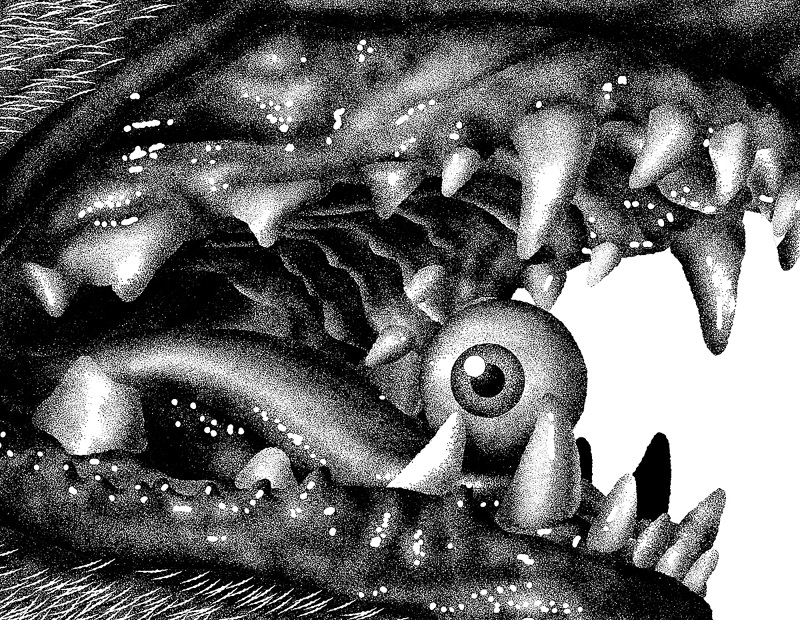
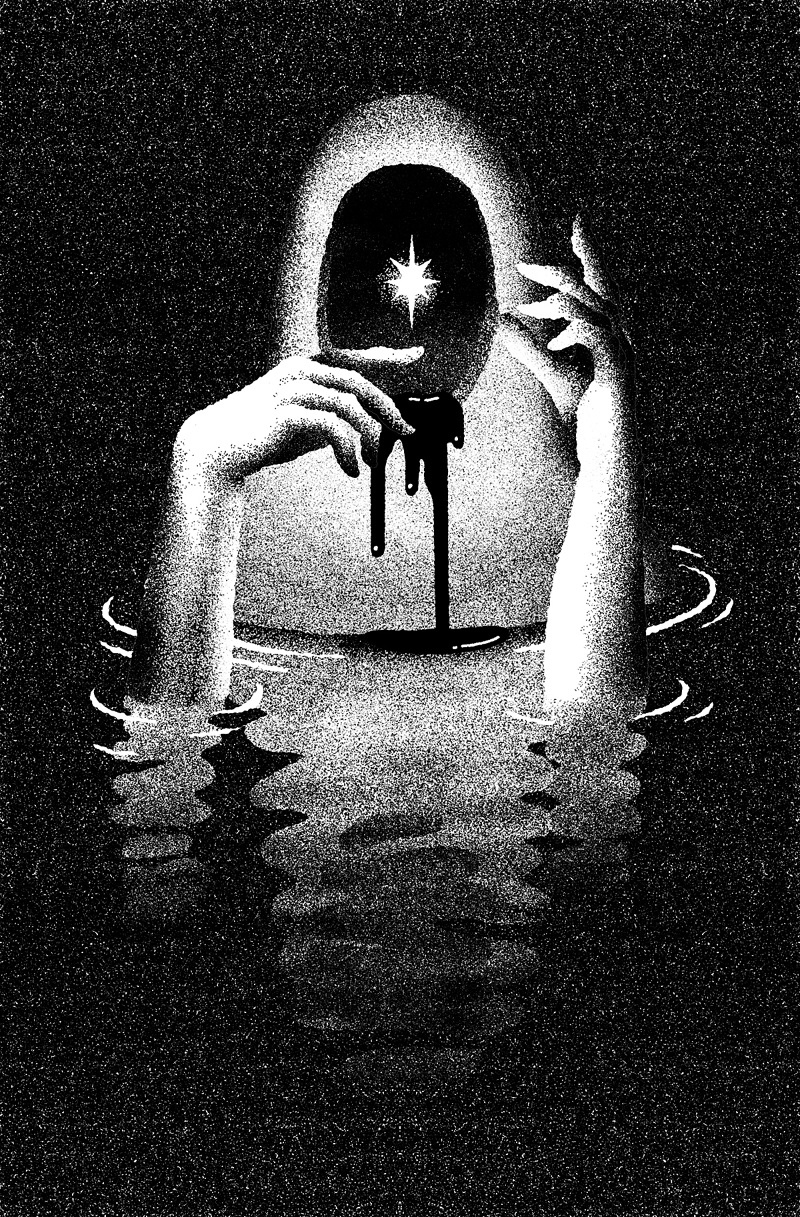
Most of your work seems to be characterised by a certain leitmotif. Could you try to describe what that leitmotif is?
Well, leitmotif sounds too grand for me. I'd prefer to call it a symbol. The eyeball might be the most recurring symbol I use. I see it as a kind of hero, reduced to one of the smallest human gestures, a glance or an 'eyebeam'. This seemingly always observing hero is sent on a quest through awkward situations. For example, he finds himself between the fangs of a hound while darting an eyebeam at the viewer. I like to get people involved immediately this way, so that they are confronted with something, even if it's unpleasant.
I’m fascinated by the ambivalence of ancient Greek architecture too. A kind of all-white, ageless beauty in its purest form, the romantic tragedy of a civilisation long gone. I have a romantic, fairly naive picture of ancient times in my head, about which I feel very nostalgic: a slower, thoughtful life without distraction, with a recollection of minimalistic and purist aesthetics. By using the pictorial world of this kind, I’m able to create a small refuge from the confusing present and daily routine. I use this beauty of the ancient, and set it in contrast to my mood or worldview of the present in general. It often has this dark and heavy atmosphere with a lot of shadows, spiky objects like nails or teeth, unidentifiable amounts of fluids, huddled bodies and inanimate objects. This ambivalence I think, derives immediately from my self as a person who enjoys to wrap itself into this old, rough blanket called melancholy. It’s like a valve for myself I guess, it’s how I try to dissociate from the mad stuff in order to avoid drowning in it.
When you say that your illustrations should be “seen as a sullen and bitter smirk towards the obscurity, monotony and ferocity of everyday life”, are you referring to anything specific? The impact of personal technologies on communication perhaps?
Well, it’s mostly stuff which get’s me down in a certain moment, local to global. This may be a dog leashed in front of the supermarket, the effort people expend to please complete strangers on social media, the inability for friends to talk about what really bothers them, my biases or heavy storms in the middle of Germany. In my latest illustrations however, communication in the digital age and the role of the individual therein is an issue for sure. We’re facing an increasingly fast-paced stream of information and media, and I am starting to feel overwhelmed, personally. I mean, who can filter out all the rubbish nowadays? The digital era feels like an age of distraction or dissociation and although social communication has become way easier, it’s harder to really get through to a person.
Well, leitmotif sounds too grand for me. I'd prefer to call it a symbol. The eyeball might be the most recurring symbol I use. I see it as a kind of hero, reduced to one of the smallest human gestures, a glance or an 'eyebeam'. This seemingly always observing hero is sent on a quest through awkward situations. For example, he finds himself between the fangs of a hound while darting an eyebeam at the viewer. I like to get people involved immediately this way, so that they are confronted with something, even if it's unpleasant.
I’m fascinated by the ambivalence of ancient Greek architecture too. A kind of all-white, ageless beauty in its purest form, the romantic tragedy of a civilisation long gone. I have a romantic, fairly naive picture of ancient times in my head, about which I feel very nostalgic: a slower, thoughtful life without distraction, with a recollection of minimalistic and purist aesthetics. By using the pictorial world of this kind, I’m able to create a small refuge from the confusing present and daily routine. I use this beauty of the ancient, and set it in contrast to my mood or worldview of the present in general. It often has this dark and heavy atmosphere with a lot of shadows, spiky objects like nails or teeth, unidentifiable amounts of fluids, huddled bodies and inanimate objects. This ambivalence I think, derives immediately from my self as a person who enjoys to wrap itself into this old, rough blanket called melancholy. It’s like a valve for myself I guess, it’s how I try to dissociate from the mad stuff in order to avoid drowning in it.
When you say that your illustrations should be “seen as a sullen and bitter smirk towards the obscurity, monotony and ferocity of everyday life”, are you referring to anything specific? The impact of personal technologies on communication perhaps?
Well, it’s mostly stuff which get’s me down in a certain moment, local to global. This may be a dog leashed in front of the supermarket, the effort people expend to please complete strangers on social media, the inability for friends to talk about what really bothers them, my biases or heavy storms in the middle of Germany. In my latest illustrations however, communication in the digital age and the role of the individual therein is an issue for sure. We’re facing an increasingly fast-paced stream of information and media, and I am starting to feel overwhelmed, personally. I mean, who can filter out all the rubbish nowadays? The digital era feels like an age of distraction or dissociation and although social communication has become way easier, it’s harder to really get through to a person.

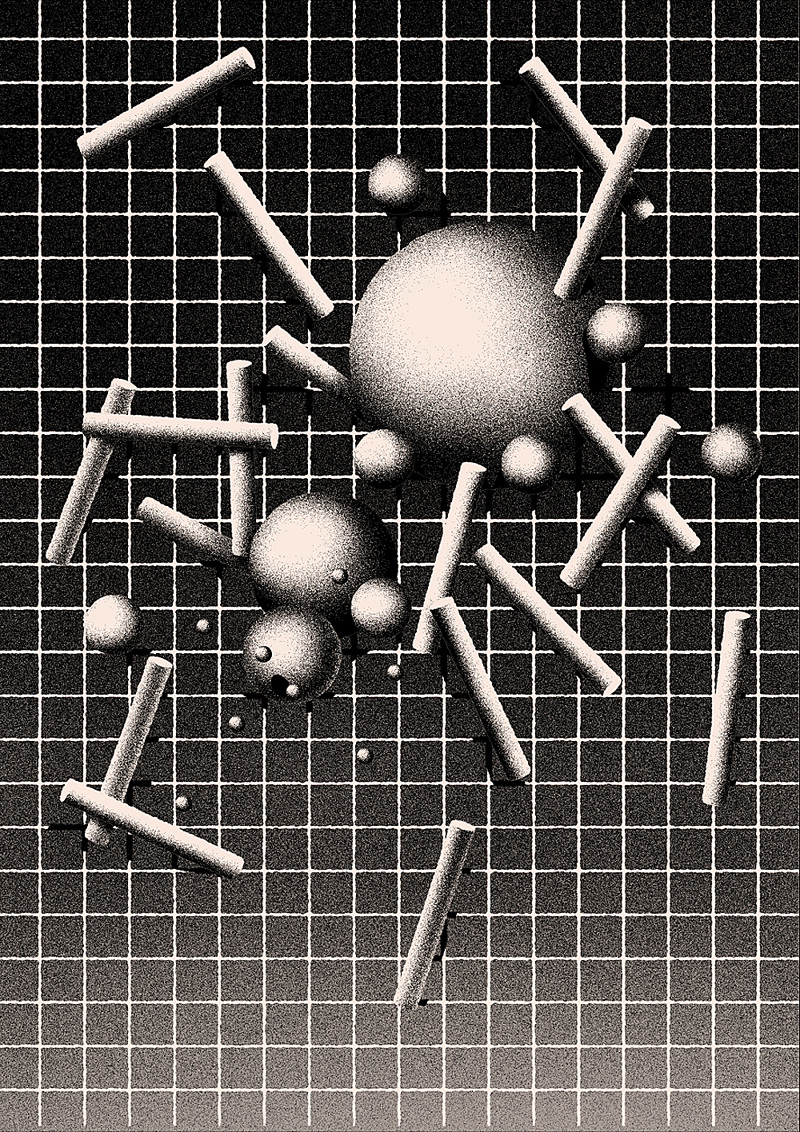
This obscurity of everyday life reminds me of the short film ’Les Escargots’ (1966) by Rene Laloux. It is a film about a farmer who tries his best to make his salad grow. It is only when he cries that his tears stimulate his salad into enormous growth. Through his suffering there’s some reward for the farmer, but his salad attracts a group of gigantic snails that decimate the nearby village. As the plot continues, the cycle repeats and the characters seemingly miss the point.
Have you seen the film, and are there any other animators or illustrators that have influenced your work?
Reading your short plot summary makes me think of the deluded, egocentric vantage point from which we experience life in general: as first world citizens we are the most privileged beings on this planet, most of the time not aware that our well-being is built upon the discomfort (if not suffering) of others far, far away (and I’m not just talking about humans, but creatures in general). All of this suffering is happening right now, every second, discomfort and suffering a million times over and all at once. But all we think about is getting another pair of sneakers or something. It’s crazy when you think about it. I’m drifting away.
A big, if not the most influential discovery for me may have been Moebius. I deeply adore his otherworldly imagination and sense for amorphic shape. Speaking of Moebius, I recently discovered his mate Druillet, who is such a master at creating fantastic worlds as well.
Staying with the Frenchmen, it’s Magritte whom I owe a lot to when it comes to disassembling things and rearranging/thinking them through a new context. A list like this wouldn’t be complete without the magical landscapes of Eyvind Earle, who inspires me when I look for a form of language. Almost forgot to mention the films of Hayao Myazaki! It's hard to find words which can describe his sublime pieces of animation.
Can you tell us a little about your collaborative book project, 'I Use My Hands to Pull My Eyelids Down & Watch the Inside of My Face'?
I met Jordan, the mastermind behind Braille Face, on an earlier album art project, so I was stoked to work with him again on his ideas for this. I very much like his experimental approach to songwriting and how he’s able to wrap it into a rather unique poetry. He actually did an album each month throughout the year of 2015. Crazy, isn’t it?! With the albums being exclusively digital releases, Jordan wished for a physical counterpart on this planet. That’s where I got on board: he asked me to do one illustration for a certain song of each of the 12 albums, and arrange them in a small riso-zine. It was quite a task to find a visual translation to his very poetic and cryptic lyrics in the beginning. That’s why I decided to look for recurrent elements (body parts in this case), which would ease the process and provide me with a certain fertile ground to let the illustrations grow from. So when I read the line, "And watch the inside of my face” for example, I knew immediately that I could use an eyeball as a protagonist. In the end I think the both of us were pretty happy with how it turned out.
How important a role does literature / poetry / word fragments / music, play in relation to the imagery you create?
Talking about the role of literature, I guess it lies in the nature of words or text to stimulate visual imagination. They serve as perfect picture generators so to speak. Also, it lies in the nature of the eye to want to draw a connection between things, especially if these things are arranged on the pages of a book. In “Daymare Boogie” I experimented with word fragments (“Dullness”, “Distress”, “Live slow, die old”) and questions (“Do you want to live forever?”, “Do you think you matter more if you possess more?” or “Do you know what's eating you?”) alongside my illustrations for the first time. By making use of these aforementioned circumstances, I treated the words as placeholders or free space for contemplation: a sudden call for the viewer’s imagination to complete the story themselves.
![]()
![]()
![]()
Further Reading ︎
Reading your short plot summary makes me think of the deluded, egocentric vantage point from which we experience life in general: as first world citizens we are the most privileged beings on this planet, most of the time not aware that our well-being is built upon the discomfort (if not suffering) of others far, far away (and I’m not just talking about humans, but creatures in general). All of this suffering is happening right now, every second, discomfort and suffering a million times over and all at once. But all we think about is getting another pair of sneakers or something. It’s crazy when you think about it. I’m drifting away.
“At least for some - maybe most of us -
how we are regarded by others is still more important than how we regard ourselves.”
A big, if not the most influential discovery for me may have been Moebius. I deeply adore his otherworldly imagination and sense for amorphic shape. Speaking of Moebius, I recently discovered his mate Druillet, who is such a master at creating fantastic worlds as well.
Staying with the Frenchmen, it’s Magritte whom I owe a lot to when it comes to disassembling things and rearranging/thinking them through a new context. A list like this wouldn’t be complete without the magical landscapes of Eyvind Earle, who inspires me when I look for a form of language. Almost forgot to mention the films of Hayao Myazaki! It's hard to find words which can describe his sublime pieces of animation.
Can you tell us a little about your collaborative book project, 'I Use My Hands to Pull My Eyelids Down & Watch the Inside of My Face'?
I met Jordan, the mastermind behind Braille Face, on an earlier album art project, so I was stoked to work with him again on his ideas for this. I very much like his experimental approach to songwriting and how he’s able to wrap it into a rather unique poetry. He actually did an album each month throughout the year of 2015. Crazy, isn’t it?! With the albums being exclusively digital releases, Jordan wished for a physical counterpart on this planet. That’s where I got on board: he asked me to do one illustration for a certain song of each of the 12 albums, and arrange them in a small riso-zine. It was quite a task to find a visual translation to his very poetic and cryptic lyrics in the beginning. That’s why I decided to look for recurrent elements (body parts in this case), which would ease the process and provide me with a certain fertile ground to let the illustrations grow from. So when I read the line, "And watch the inside of my face” for example, I knew immediately that I could use an eyeball as a protagonist. In the end I think the both of us were pretty happy with how it turned out.
How important a role does literature / poetry / word fragments / music, play in relation to the imagery you create?
Talking about the role of literature, I guess it lies in the nature of words or text to stimulate visual imagination. They serve as perfect picture generators so to speak. Also, it lies in the nature of the eye to want to draw a connection between things, especially if these things are arranged on the pages of a book. In “Daymare Boogie” I experimented with word fragments (“Dullness”, “Distress”, “Live slow, die old”) and questions (“Do you want to live forever?”, “Do you think you matter more if you possess more?” or “Do you know what's eating you?”) alongside my illustrations for the first time. By making use of these aforementioned circumstances, I treated the words as placeholders or free space for contemplation: a sudden call for the viewer’s imagination to complete the story themselves.



Further Reading ︎
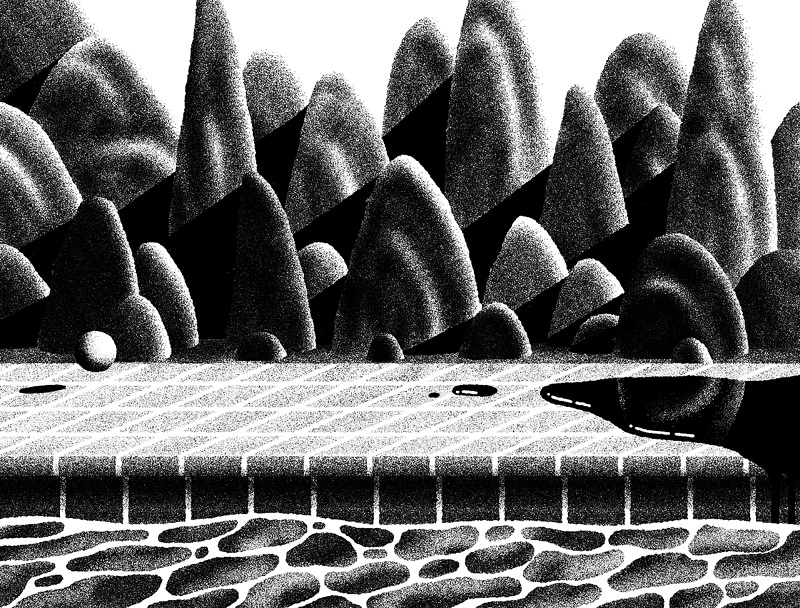

Are you working on any new projects at the moment?
Right now, I’m working on projects for several bands, as well as editorial illustrations for some magazines, but I’m feeling the hunger for a personal project getting stronger and stronger again. I have a steady list of future projects and ideas constantly rattling around too, such as working myself into doing a short movie and movie poster illustration series and so on. Though most exciting is an idea for a project which came to me just recently, while I was at an Amenra concert. Their opening act, Syndrome, a heavy brooding drone/ambient one-man show, had these amazing projected visual textures of different natural elements like wafting reeds for example. The combination of the soundwalls and the emerging atmosphere somehow gave birth to a rather poetic story in my head where each sentence is made of a maximum of two words. I now would like to explore this story visually and put it into a suitable medium.
What do you think we should be relieved about in the future?
Maybe we should be more honest with ourselves: accept the full spectrum of emotions instead of hiding the negative parts. At least for some - maybe most of us - how we are regarded by others is still more important than how we regard ourselves. We adapt trends, we align, we create a digital “having a good time” self and leave out the unpleasant stuff. The worst about that is, it feels like most of the time this all happens without calling it into question. Why not just stop pretending?
